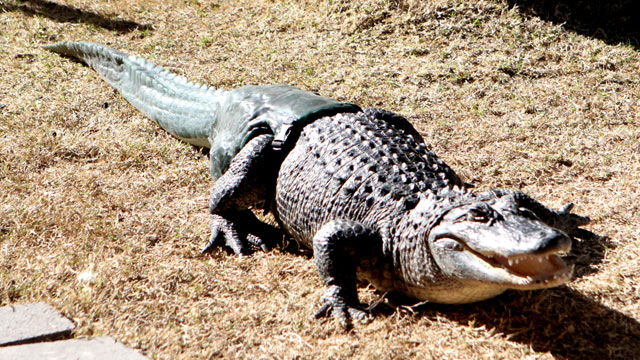Gator Aid

Alligators’ tails allow them to swim. By moving their tails from side to side, the animal can propel itself through the water at fish-like speeds, which is important because when it comes to eating, alligators have a pretty easily defined diet: if it’s in or near the water, it’s food. (Floridians note: this applies to alleged burglars.) In fact, sometimes alligators try to eat other, smaller alligators. That is the tale of the tail of the alligator now known as Mr. Stubbs.
In 2005, according to USA Today, authorities in Arizona pulled over a truck (for reasons unclear) only to find that it was carrying an illegal payload of 32 alligators. To make things even weirder, the 32 alligators only had 31 tails between them. One of the alligators, later determined to be three years old, had somehow lost his tail. X-rays suggested that it had been bitten off by another alligator, but regardless, the lack of tail made it hard to swim.
The solution: a prosthesis, as seen below.

The alligator, named Mr. Stubbs due to his lack of a second half, found a home with the Phoenix Herpetological Society (PHS), which provides rescue and rehabilitation services for reptiles in Arizona. They partnered with the Core Institute Center for Orthopedic Research and Education and Midwestern University to develop a new tail so that Mr. Stubbs could take back to the water. The idea, which took three months and thousands of dollars in materials, was experimental, to say the least — according to AZCentral.com, Mr. Stubbs’ tail is the first of its kind. The idea was to connect the new tail to his hind legs, allowing him to use his pelvis to wiggle the tail back and forth much like he would a normal tail.
After a while, researchers were able to attach the prothesis to a patient who can’t communicate with the doctors — an accomplishment in its own right. But there was more to be done. Shortly after Mr. Stubbs was rescued from the smuggling operation, the team at PHS had already taught Mr. Stubbs how to swim without a tail (although not nearly as well) by employing the alligator-equivalent of the doggie paddle. The prosthesis wasn’t an option until years later, and didn’t become a long-term option until 2013. Therefore, they had to re-teach Mr. Stubbs how to use it. “You have to remember, his body has memory but he’s been swimming this way for eight years and you’re putting an attachment on there,” Russ Johnson, the president of PHS, told ABC News. “It took about six months to swim dog-paddling, and I figured it will take three to six months to teach him to swim with a tail.”
Eventually, it worked. Here’s a video of Mr. Stubbs swimming:
Mr. Stubbs should be able to live — with a fake tail — for decades. He’ll do so at PHS, though; there are no plans, to reintroduce Mr. Stubbs into the wild.
Bonus Fact: Alligators and crocodiles aren’t the same animals. The Crocodilian Biology Database runs through the differences, with pictures, but the most obvious difference is the shapes of their snouts. Alligators have rounded, shovel-like ones, while crocodiles have triangular-ish ones that come to a point. (This is annoying because “Alligator starts with “A,” which is pointed, while “C,” as in “Crocodile,” is rounded. That would be a great way to remember this typically trivial fact, but it gives a backward result.)
From the Archives: Crocodile Miles: Yikes.
Take the Quiz: Can you tell the difference between an alligator and a crocodile?
Related: Alligator jerky, in case you want to turn the tables and bite an alligator for a change. Beware, though, the reviews (read them here) are a bit mixed.
